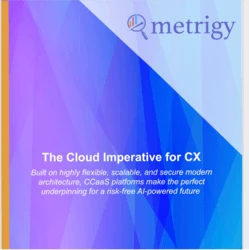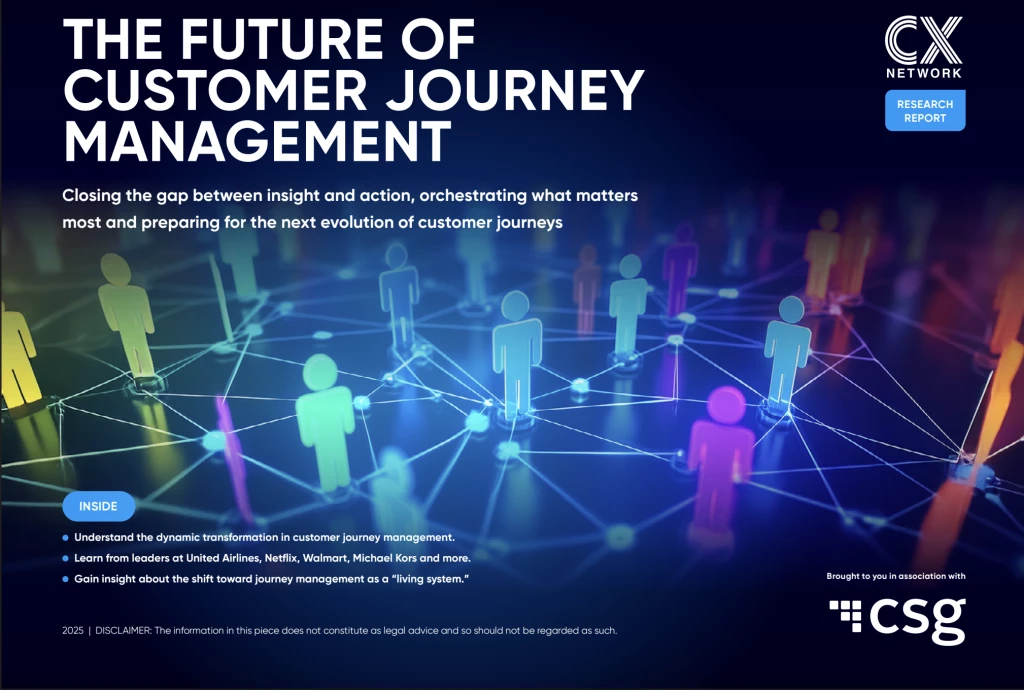Sharpen identity management with key drivers in Asia-Pacific, Middle East & Africa
Learn how CX professionals are using identity management and overcoming data fragmentation to enhance customer retention and lifetime values
Add bookmark
The duty to sharpen identity management should not be ignored
Poorly organized customer identity data can lead brands to deliver impersonal and frustrating experiences that can permanently damage customer loyalty levels. Disorganized customer identity data can generate bad customer brand experiences such as annoying customers with unnecessary advertisements and promotions for products they have already purchased. In fact, research from Gartner has found that brands risk losing 38 percent of customers if they deliver badly targeted marketing personalization efforts.
Also read: VoC in APAC experts insights ebook
CX Network’s Big Book of Customer Insight and Analytics 2021 has revealed that many brands are at high risk of delivering poorly targeted marketing efforts as the research data confirmed the widespread struggle across many businesses to ensure data sets are well organized, with more than two thirds of respondents (68 percent) citing this issue.
With Google’s fast approaching move to advance away from cookie technologies, the urgency to optimize customer identity data management has never been stronger.
In an effort to support brands to improve identity management practices, this CX Network report draws on insights from 195 CX and marketing experts based in Asia-Pacific, the Middle East and Africa on their key drivers for customer identity management. The report dives into the state of data collection, investment strategies and the strategic improvements being deployed with identity management to reach the right customers at the right time. Respondents also reveal how they are responding to Google’s plan to phase out third-party cookies by 2023.
“Businesses need to prioritize understanding their data footprint and enhancing data strategies, which must include leveraging first-party data to drive optimal customer experiences.”
Patrick Sim
Senior VP and head of sales of APAC and MEA at Epsilon
About the research respondents
To get a better understanding of the survey results, here is a visual breakdown of the 196 industry experts surveyed, including their seniority, company size, industry and geography.
Job title

Function

Industry

Regions you operate within

Data infrastructure and first-party data strategies
What is the maturity of your company’s first-party data capture strategy?

Are you able to manage marketing programs without depending on third-party platforms?
 Fact:
Fact:
Brands with advanced first-party data capture strategies express the most confidence in managing marketing programs without depending on third-party platforms.
Describe your organization’s data infrastructure

Definitions
First-party data: The data a brand has collected themselves about their own customers.
Third-party data: Data collected by a third-party entity from a range of sources.
Cookies: Data files collected to help identify a user when their device visits a website for the first time. The information collected, such as ID tags, web pages visited, time spent on page and products browsed, have been historically used to personalize the experiences they can provide to users when they return.
As the future of cookie-based customer engagement is under question, with Google Chrome leading the move away from supporting cookie technologies, there is added urgency for brands to address their own identity data infrastructure weaknesses to ensure data is well organized and not fragmented across company divisions. Despite this, 24 percent of respondents have data that is siloed by channel or business function.
Over 60 percent of those surveyed suffer from incomplete customer profiles, relating to gaps in first-party data held on customers. These incomplete customer profiles place a company’s customer engagement tactics at risk of being disjointed, leading to long gaps between touchpoints or frustrating interactions that fail to reflect the customer’s preferences.
Without a strategy to guide data capture, brands are at risk of intensifying the issue of fragmented customer profiles. The majority of responding CX and marketing experts admitted to having under-developed data capture strategies. Just over 40 percent of those surveyed are in the early stages of rolling out first party data capture strategies. The majority of respondents also admitted they do not enrich their first party data with third-party data and 36 per cent of respondents are unable to manage marketing programs without depending on third-party platforms. Those with advanced first party data strategies were more likely to have holistic profiles or a more complete view of the customer.
Fact:
Brands suffering from data silos expressed the least confidence in managing marketing programs without third-party platforms.
Reflecting on the results Patrick Sim, Senior VP and head of sales of APAC and MEA at Epsilon, warns that in the long term, dependency on third-party data alone is not sustainable.
“Campaigns run on third-party platforms rarely provide customer intelligence to companies, and this lack of intelligence in the system leads to a vicious cycle of continued dependence on these platforms,” Sim says. “The solution is to invest in owned platforms and software for customer engagement, allowing for relevant, timely and compelling communication.
“Businesses need to prioritize gaining an understanding of their data footprint and enhancing their data strategies, which must include capturing and leveraging first-party data to drive optimal customer experiences.”
“Due diligence is key and cannot be ignored.”
Collin Larijan
Senior director solution consulting of APAC and MEA at Epsilon
ID program use cases and effectiveness
Use cases for customer ID programs
Please note: Respondents could select multiple answers
Planning

Execution

Measurement

Programs dedicated to the accurate identification of customers will empower brands to optimize the personalization and targeted relevance of customer engagement campaigns. UAE-based conglomerate Majid Al Futtaim, which operates 26 shopping malls across the Middle East, managed to double its marketing engagement conversion rates from 15 to 30 per cent following its data initiative that ensured employees had a single version of the truth about customer identities.
Also read: Data & analytics in APAC CX network
One stage tackled incomplete data and led to 20 million customer records being narrowed down to approximately eight million after data cleansing and identifier deduplication. The insights into customer preferences obtained increased experience customization in its VOC Cinemas division and the cleaner data ensured marketing campaigns reached their intended recipients. Only 35 percent of the research group are prioritizing customer profile development, which is a foundational element of preparing successful ID programs. Instead, a vast portion of the experts are jumping ahead and focusing on optimizing campaigns and increasing targeted engagement. To fast-track the accuracy and success of optimizing campaigns and engagement, marketers and CX practitioners should first dedicate focus on laying a firm foundation for ID programs by correcting incomplete customer profiles.
The data fragmentation seen in the previous section of the research appears to be complicating the effectiveness of customer ID programs for our respondents. Only eight per cent of the experts surveyed believe their customer ID programs effectively increase customer lifetime values. Also, just 17 percent of respondents believe that they are skilled at reducing marketing waste within their own business.
“Wasted marketing spend can be directly linked to the negative perception of marketing being seen as a cost center,” says Sim from Epsilon. Internal tech and operational data silos often block marketers and CX practitioners from being able to calculate how their efforts contribute to revenue attribution. Sim continues: “We are seeing that the organizations with marketing and tech decisions being made in true partnership, yield dramatic results in proving marketing efficiency and respect for the long-term vision that marketing can own, freeing the function from short-term campaign performance judgements.”
Cookies appear to be a more popular customer identifier over the likes of loyalty programs and account numbers.
Also, only 11 percent of the respondents use a combination of all the 13 listed customer identifiers. In order to optimize identity management, as well as running data hygiene campaigns to tackle incomplete data like Majid Al Futtaim did, respondents should consider utilizing a broader range of identifiers and avoid relying on cookie technology. If utilizing a broader range of identifiers is too arduous, while some technologies demand a wide set of identifiers, systems like Epsilon’s proprietary technology simplify requirements down to only needing two data points that can be tracked to create an ID.
Most popular customer identifiers
Please note: Respondents could select multiple answers

Tackling problems with ID programs

When those surveyed assessed the consequences of poor customer ID management, limited analytics capabilities was voted as the toughest issue.
Analytics capabilities allow companies to enhance engagement strategies by better understanding customer behaviors and preferences. CX practitioners and marketers can use analytic insights on channels such as webpages, social media and self-service portals to determine what buyers prefer engaging with and adapt accordingly.
Neil Gardner, chief customer officer at Generali Asia, remarks that to build strong customer engagement strategies: “You have got to find relevance, use content, evolve your products, boost your customer understanding and know their journeys really well.”
Past customer journeys can be analyzed so future customer journeys can be anticipated and their outcomes can be optimized, however, many of the professionals surveyed admit to struggling with basic roadblocks. Indeed, 32 percent of respondents are still reaching out to the wrong customer because of poor customer identity management. This is a common mistake when operating with incomplete data, which is the reality for 60 percent of professionals in this research as seen in the earlier data infrastructure section of this report.
Also read: CX Automation in APAC
To address the issues created by poor ID management, the majority of respondents are upskilling employees and developing effective in-house teams to upgrade identity management programs to deliver meaningful interactions with customers.
The importance of memorable customer experiences was emphasized for Generali Asia’s Gardner when his research showed that in the Southeast Asian market only 50 per cent of customers remember receiving messages from their insurance company. “If we are not making memorable contact points with customers, then, quite frankly, we are not making contact at all,”Gardner surmises.
Successes available from improving ID programs
Top benefits from improving customer identity capabilities
Please note: Respondents could select multiple answers

From improving customer identity management, over 41 per cent of the respondents manage to secure more effective marketing measurement. This added visibility of campaign success will empower brands to evolve and deliver better to the range of consumer demands, concerns and preferences. Reliance Jio Infocomm Limited head of customer experience Suman Kargupta believes that establishing customer-focused, personalized business strategies allowed the Indian telecommunications company to mature from focusing on “customer satisfaction” to realigning its focus to “customer delight”.
Better adherence to privacy controls and opt-outs also appears as one of the top five benefits. This is a significant advantage as legally businesses must commit to ensuring the people interacting with their services are protected. Equally, data misuse has far-reaching impact on customer trust, with a 2019 Ping Identity report finding that 81 percent of customers would stop engaging with a brand following a data breach.
Improved visibility on past-purchasing behaviors and customer preferences through good data management can have a direct impact on a company’s bottom line through enhanced cross-selling and up-selling. This information can reveal which customer segments are most likely to convert on a particular up-sell or which product bundling suggestions are best for a cross-sell with existing customers. This is a valuable advantage as industry studies indicate it is between five to 25 times more expensive to acquire a new customer than it is to retain and resell to an existing one.
Identity program objectives for the next 12 months
Top marketing objectives over the next 12 months
Please note: Respondents could select multiple answers

“Campaigns run on third-party platforms rarely provide customer intelligence to companies, and this lack of intelligence in the system leads to a vicious cycle of continued dependence on these platforms.”
Patrick Sim
Senior VP and head of sales of APAC and MEA at Epsilon
According to our survey respondents, there is room for improvement with customer engagement and identity data management as they admit that at points, they can struggle to understand who they are reaching out to, with 32 percent of respondents admitting to reaching out to the wrong customer at times, alongside how to balance the desire for privacy with engagement innovation.
When asked for their organization’s top marketing objectives over the next 12 months, improved customer satisfaction and a healthier balance of media emerged as high priorities.
Customer feedback is vital for improving customer satisfaction. Cynthia Tang, senior manager of customer experience at Sunway Malls, notes that this rang true for Mall’s integration of its smart-parking initiative.
“We needed to walk through the customer journey as despite the large number of complaints, we had to roll out the system anyway,” Tang says. “We had to just bite the bullet, and all this feedback was actually very important, because we needed to know where the pain points were and how to resolve them.”
The respondents are seemingly aware that outreach tactics to customers must borrow from multiple mediums, creating a multifaceted experience that is engaging and creative. According to a Wyzowl report, 83 percent of businesses feel video ads provide good return on investment, which also appears as a key priority for our respondents.
While 61 percent plan to alter their engagement strategies in light of Google’s cookie depreciation, the remaining 39 percent would be wise to respond to Google’s announcement as Google Chrome accounts for 69 per cent of desktop browser usage. Nagesh Govindaiah, Senior director solution consulting of APAC and MEA at Epsilon, notes that: “Overall, brands will face two broad challenges with cookie depreciation: difficulty in personalizing their marketing and complications with optimizing performance and ROI.
“Without identifiers, in the post cookie deprecation world brands will lose the ability to understand customers, which often results in a less desirable customer experience and increased marketing waste.”
How to navigate cookie depreciation
Nagesh Govindaiah
Senior director solution consulting of APAC and MEA at Epsilon
“Using a combination of third-party cookies and first party data capture strategies, marketers can start building customer data platforms that are designed for enterprise success fit with a single view of customers, refined segments, real-time decision making and better campaign measurement, all while exceeding regulatory requirements on security and privacy.”
61 percent are planning to alter their customer engagement strategy around the deprecation of third-party cookies by Google.
Identity management investment strategies
Customer identity management investment budget plans for the next 12 months

The primary area of investments

The research group plans to either maintain or slightly increase spending on customer identity initiatives.
Those participants who are seeing a decrease in budget are prioritizing spend towards foundational necessities such as improving privacy safeguards. Where budgets are increasing, market research and third-party services appear as the leading areas of financial investment, which reflects the preparation needed for the shift in cookie technology usage. The second most-popular area of investment is the hiring and training of personnel. This evidences the commitment to investing in internal teams around overcoming identity management problems. In-house expertise can also be utilized for building new tech features that can enhance identity management practices.
Looking at strategic preferences around developing tech capabilities, respondents indicated they would prefer to build the majority of the categories assessed using in-house expertise except for AI programs. Building bespoke systems with in-house resourcing provides control and flexibility to create tech solutions that are customized to the business’ exact needs. This path, however, often requires extensive resources, training and testing to do effectively.
Buying off-the-shelf from a solution provider gives the convenience of benefiting from a tried-and-tested technology. Also, the technical expertise of the provider can support with best practices for onboarding and feature usage, which can be extremely useful when brands need to enter unchartered territory or execute a swift roll out.
Vendor selection for program success
Top characteristics of an identity resolution partner
Please note: Respondents could select multiple answers

To combat the prevalence of data siloes enterprises are looking to customer data platforms (CDPs) to unify sources and complete customer profiles.
On the topic of combatting data silos, Saki Takeda, director of product management at Netflix, told CX Network: “It’s important to think about data holistically and prioritize investments in building a strong data infrastructure that will surface 360-degree customer views and provide end-to-end visibility of customer journeys and experiences.”
The most important features of a customer data platform
Please note: Respondents could select multiple answers

Indeed, unified customer profiles are listed by our respondents as one of the most important features of CDPs only preceded by audience segmentation.
Accuracy and compliance emerged as the most desired traits of an identity resolution partner, beating cost. These are both traits brands will need to vet before partnering with a provider that can support them with managing customer identity data more effectively. “Due diligence is key and cannot be ignored,” advises Collin Larijani, Senior director solution consulting of APAC and MEA at Epsilon.
An ideal identity resolution partner will recognize the required balance between respecting customer privacy regulations while delivering intuitive, personalized, data-informed customer experiences that allow customers to feel valued.
“Overall, brands will face two broad challenges with cookie depreciation: difficulty in personalizing their marketing and complications with optimizing performance and ROI.”
Nagesh Govindaiah
Senior director solution consulting of APAC and MEA at Epsilon
Checklist: four critical elements for successful CDP strategy and implementation
Companies with successful CDP campaigns build on these four key foundational elements.
- Single customer view
- Segmentation and insights
- Real-time decision-making
- Orchestration and measurement
Tips for stress testing an identity management provider
Collin Larijani
Senior director solution consulting of APAC and MEA at Epsilon
“Start with the companies that have a proven track record in this area. Look for providers that are dedicated to enterprise level needs, such as scale and security, and are built for that, versus those who simply piggyback on cloud services’ ability to scale.
“Remember, the real worth, success, and effectiveness of an identity management provider can only be determined by putting it to the test. Start with a Proof of Concept (POC) test. Work with the vendor to run tests on their platform to see how well their system actually unifies profiles. Check the match-rates and reach-rates in advance to ensure the vendor can easily meet, or exceed, expectations.”
Final remarks
Organizing and prioritizing customer identity data can be time and resource consuming, but the rewards can empower brands to deliver loyalty-winning experiences. In the mission to develop identity data practices, the research shows the activities attracting the most attention are optimizing campaigns and increasing targeted engagement. Considering the fact that the majority of participants admit to struggling with incomplete customer profiles, industry experts are advised to ensure they prioritize dedicating focus to laying a firm foundation for ID programs by addressing existing gaps in customer profiles.
As companies can no longer depend on decaying cookie technology, it is encouraging to see that most respondents are committed to altering strategies in light of Google’s announcement. A high percentage admitted, however, that they still heavily rely on cookies in order to identify customers. Brands who neglect to take action and prepare will lose visibility on their customers and in turn can expect to experience difficulty in personalizing marketing, complications with optimizing ROI and increases to marketing waste.
The consensus to increase spend and focus on customer identity data management will be crucial to winning the hearts and minds of customers going forward. Market research and third-party services appear as the leading areas of financial investment, which reflects the preparation needed for the shift in cookie technology usage. The second most-popular area of investment is the hiring and training of personnel to bolster employee skillsets to help overcome identity management problems. To build world-class brand experiences, similar to the example set by many of the globe’s CX leaders, companies must consider investing in platforms that can craft direct relationships with customers and nurture strong one-to-one connections with individualized engagement techniques. Such investment strategies will empower Asia-Pacific, Middle East and African brands to gain advantage over their slower moving competitors by boosting customer lifetime values and retention levels.
With the decline of cookie technologies, more than ever CX practitioners and marketers should conduct frequent assessments of their data management and customer engagement strategies to ensure customer segmentation is accurate. Where necessary they should seek the support of identity enrichment experts to construct smooth customer journeys with interactions that will boost customer lifetime values.






















